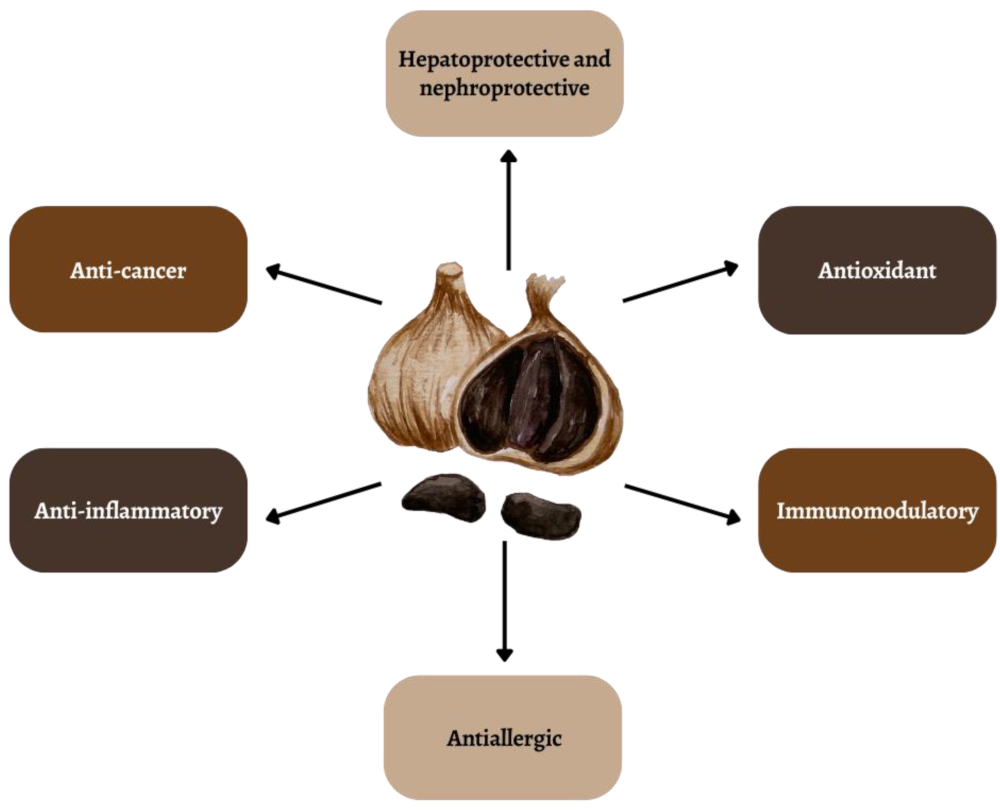Aged Garlic vs. Raw Garlic: Antioxidant and Anti-Inflammatory Profiles

When it comes to harnessing garlic’s health-boosting properties, two forms stand out: raw garlic, rich in the unstable compound allicin, and aged garlic extract (AGE), which is prized for its stable antioxidant S-allylcysteine (SAC). Both varieties have unique profiles that support our body’s defense against oxidative stress, inflammation, and even cancer. In this post, we’ll compare raw and aged garlic’s key bioactives, then summarize what the latest meta-analyses reveal about their impact on cancer markers, inflammation levels, and gut microbiome diversity.
1. Raw Garlic & Allicin: A Burst of Potent but Fleeting Activity
-
Allicin Formation
When garlic cloves are crushed or chopped, the enzyme alliinase converts the amino acid alliin into allicin, a sulfur-rich molecule responsible for garlic’s pungent aroma and many of its bioactive effects(sciencedirect.com). -
Antioxidant Power
Allicin acts as a potent scavenger of reactive oxygen species (ROS), protecting cells from oxidative damage. In preclinical models, allicin was shown to inhibit cardiac hypertrophy by reducing ROS and downregulating pro-inflammatory signaling pathways like MAPK and PI3K/Akt/GSK3β(lpi.oregonstate.edu). -
Anti-Inflammatory Effects
Beyond antioxidant action, allicin modulates immune responses by enhancing macrophage, lymphocyte, and natural killer cell activity, while suppressing excessive inflammatory cytokines in animal studies(pmc.ncbi.nlm.nih.gov). -
Limitations of Allicin
Unfortunately, allicin is highly unstable—heat, pH changes, and even storage degrade it within minutes to hours, which makes it challenging to deliver consistent doses via diet or supplements(en.wikipedia.org).
2. Aged Garlic Extract & S-Allylcysteine: Stability Meets Bioactivity
-
From Garlic to Aged Extract
Aged garlic extract (AGE) is produced by storing fresh garlic under controlled conditions (often 10–20 months), during which time unstable sulfur compounds transform into odorless, water-soluble derivatives—chiefly S-allylcysteine (SAC)(pmc.ncbi.nlm.nih.gov). -
S-Allylcysteine’s Antioxidant Profile
SAC is remarkably stable and bioavailable. Meta-analyses of clinical trials show that AGE supplementation significantly increases total antioxidant capacity (TAC) and lowers markers of lipid peroxidation (e.g., malondialdehyde) in humans, reflecting robust systemic antioxidant effects(researchgate.net). -
Anti-Inflammatory Properties
In a meta-analysis of 17 randomized controlled trials, garlic supplements (including AGE) reduced circulating C-reactive protein (CRP) and tumor necrosis factor-α (TNF-α), though effects on interleukin-6 (IL-6) were mixed. Subgroup analysis revealed that aged garlic extract was especially effective at lowering CRP and TNF-α levels(pubmed.ncbi.nlm.nih.gov).
3. Impact on Cancer Markers: What the Meta-Analyses Show
-
Gastrointestinal Cancer Risk
A landmark meta-analysis pooling studies on stomach and colorectal cancer found that high raw garlic intake was associated with a protective effect against these cancers (relative risk reductions ranging roughly 20–30%), though heterogeneity and confounding factors mean results should be interpreted with caution(pubmed.ncbi.nlm.nih.gov). -
Gastric Cancer Mortality
Another systematic review and meta-analysis observed that high-dose garlic (both raw and extract forms) reduced gastric cancer mortality, suggesting garlic compounds may slow tumor progression or enhance treatment responses(wcrj.net). -
Limitations & Inconsistencies
Not all studies agree—some cohort analyses found no significant link between garlic supplementation and lower breast, lung, or endometrial cancer risk(sciencedirect.com). Differences in garlic form (raw vs. aged), dosage, and study design contribute to mixed outcomes.
4. Inflammation: Calming the Body’s Fire
-
CRP, TNF-α & IL-6
Chronic, low-grade inflammation underpins conditions from arthritis to heart disease. The 17-trial meta-analysis highlighted that garlic supplementation reduced CRP and TNF-α significantly, but had neutral effects on IL-6 overall. Importantly, aged garlic extract stood out for its stronger anti-inflammatory impact compared to raw garlic supplements(pubmed.ncbi.nlm.nih.gov). -
Mechanistic Insights
SAC and other AGE components inhibit NF-κB signaling—a master regulator of inflammation—leading to lower production of pro-inflammatory cytokines. Raw allicin similarly modulates these pathways but is less consistent due to its instability(sciencedirect.com).
5. Gut Microbiome Diversity: Feeding Friendly Flora
-
Raw Garlic’s Prebiotic Effects
Raw garlic contains fructans and inulin-type fibers that act as prebiotics, nourishing beneficial bacteria. A 2022 randomized trial showed garlic juice increased overall gut diversity (higher Shannon index) and boosted populations of Akkermansia and Faecalibacterium prausnitzii—key species linked to gut health and metabolic benefits(nature.com). -
Aged Garlic Oligosaccharides
AGE is also rich in aged garlic oligosaccharides (AGOs), which in a recent metagenomic study improved gut barrier function and modulated bacterial metabolic pathways (e.g., lipopolysaccharide biosynthesis), suggesting unique microbiome-supporting properties beyond raw garlic’s prebiotic fibers(sciencedirect.com). -
Comparative Notes
While both raw garlic and AGE can enrich microbiome diversity, raw garlic’s prebiotic fibers tend to act more broadly, whereas AGE’s oligosaccharides and SAC may provide targeted benefits in gut barrier integrity and inflammation control.
Take-Home Message
-
Raw garlic delivers a powerful but fleeting dose of allicin, offering acute antioxidant and anti-inflammatory effects alongside prebiotic fibers for gut health.
-
Aged garlic extract (AGE) provides a stable, bioavailable antioxidant (SAC) that consistently boosts overall antioxidant capacity, lowers key inflammatory markers (CRP, TNF-α), and supports gut barrier function through AGOs.
-
Cancer Prevention: Both forms show promise against gastrointestinal cancers, but results vary by garlic type, dose, and study design.
-
Inflammation & Microbiome: AGE appears to offer more reproducible anti-inflammatory benefits, while raw garlic brings broader prebiotic support.
Ultimately, combining both raw garlic (in culinary use) and aged garlic extract (as a supplement) may offer synergistic advantages—leveraging allicin’s immediate effects alongside SAC’s lasting stability. As always, consult your healthcare provider before starting any new supplement regimen, especially if you have existing health conditions or take medications. Harnessing garlic’s dual forms can be a flavorful, natural strategy for boosting antioxidant defenses, taming inflammation, and nurturing a resilient gut microbiome.
References
-
Allicin’s pharmacological profile: (sciencedirect.com, lpi.oregonstate.edu)
-
Immunomodulatory effects of garlic: (pmc.ncbi.nlm.nih.gov)
-
SAC and AGE antioxidant mechanisms: (pmc.ncbi.nlm.nih.gov, researchgate.net)
-
Meta-analysis on inflammation markers: (pubmed.ncbi.nlm.nih.gov)
-
Cancer risk meta-analyses: (pubmed.ncbi.nlm.nih.gov, wcrj.net)
-
Gut microbiome diversity studies: (nature.com, sciencedirect.com)
Our Products
Discover Seven Years' premium aged garlic products:
- Aged Garlic in Vinegar
- Traditional Fermented Garlic
- Premium Gift Sets
- Culinary Selections
Comments (0)
No comments yet. Be the first to comment!